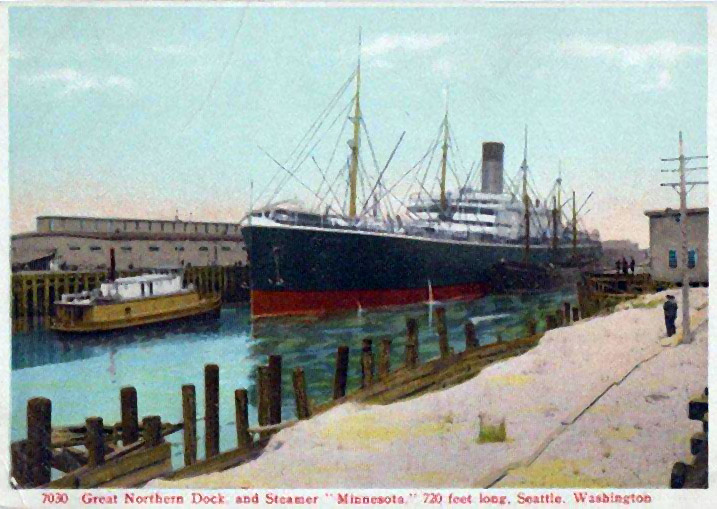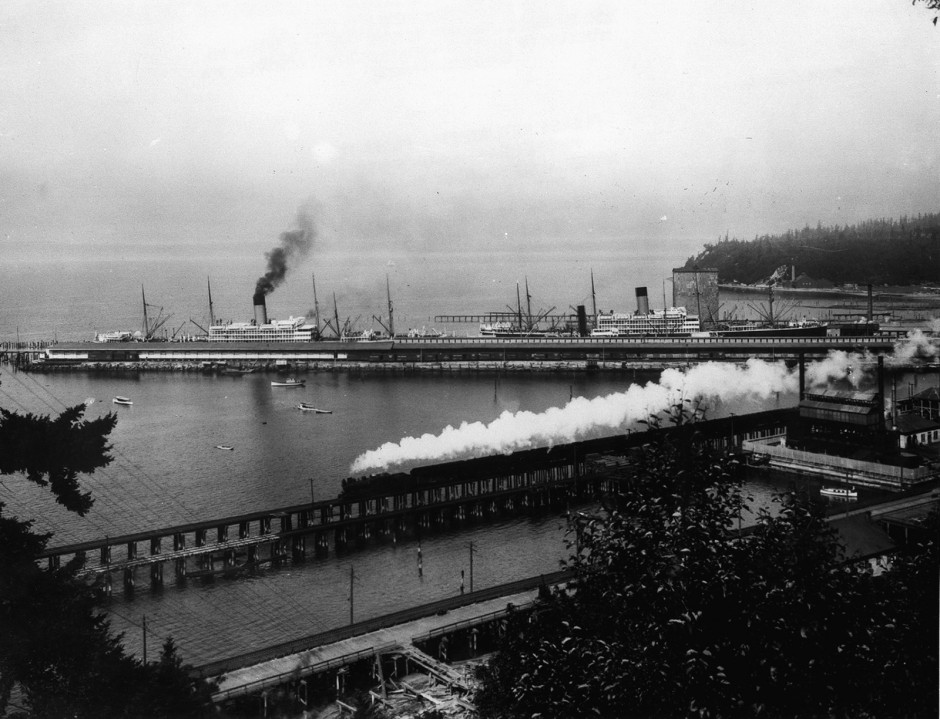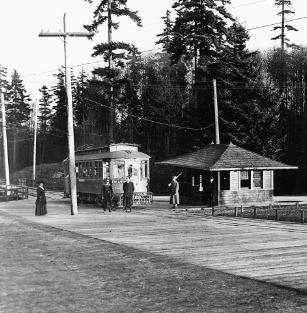Then… 112 years ago – January 23, 1905
Maiden Voyage from Smith Cove – SS Minnesota largest boat in US
By Monica Wooton
From Magnolia’s Smith Cove on January 23, 1905, the SS Minnesota set sail in its first voyage to the Orient. The largest ship to sail under the American flag, it had the cargo capacity of 100 locomotives – each 25 cars long, 9 decks, was 622 feet long and was nearly 21.000 tons that could go almost 15 knots under full steam power.

SS Minnesota in her berth at Smith Cove Pier 89. Courtesy of Ian Newsom www.atlantictransport.com Circa 1909
“The accommodations for the first class or saloon passengers are in a large deckhouse situated amidships. The great dining saloon, which can seat 200 passengers, is at the forward end of the deck house and is furnished in mahogany. Just above the dining saloon is the library on one side and the ladies’ boudoir on the other. While on the bridge deck is the smoking room, furnished in leather and Flemish oak. There is also an airy nursery and children’s play rooms on the promenade deck. The number of passengers provided for is 218 first and 68 third class, while below deck accommodations are provided for 1,300 troops (one regiment) or 2,400 steerage passengers. A unique feature is the opium den astern for the use of Orientals. 66 American officers over-saw 216 Chinese crew members who worked for wages far less than Americans.”
The ship was built for J.J. Hill, the Great Northern Railroadmagnate, to become part of the Great Northern Steamship Company. His intention was that it would serve as competition with the Japanese as part of his dream to carry passengers but mainly import the highly prized commodity of Asian silk. It was an economic money-grabbing risk that ended in a boondoggle for Hill.
A new business arrangement in 1896 with the Japanese Nippon Yusen Kaisha Line, which supplied its ships to extend the Great Northern Railroad & Pacific Railways transportation network to Japan and numerous other Asian ports did not meet Hill’s expectations for more capital. Hill had established a ship-to-rail system, which became known as the Silk Trains. He was not satisfied that the Japanese ships were big enough to really capitalize on the markets available.
Four ships were commissioned by Hill, of these the Minnesota and its sister ship the SS Dakota were the only two completed. These ships were to move grain carried by train from St. Paul, Minnesota to Smith Cove terminal to Singapore and return with precious cargo of Asian silk to Smith Cove, be unloaded onto the trains and make the return trip back to St. Paul. The Silk Trains that rushed the cargo to St. Paul for sale on a high-speed priority schedule stopped all other train traffic.
Hill was regarded as a great railroad man. His knowledge and expectations for ships were not a match for his entrepreneurial vision and success for trains. “Hill contracted with a trusted shipbuilder, who had built excellent ships that plied the Great Lakes for Hill…In hindsight, Hill made numerous mistakes in the design and building of these two giants. The Dakota and Minnesota may have suffered from Hill’s desire to make them the largest in the Pacific. The Minnesota was completed August 17, 1904, and the Dakota on March 3, 1905. Both were plagued by long delays during construction: The expected two-year building time took twice that long. Once the Minnesota was built, Hill chose to hasten things by taking delivery without sea trials by the builder. This meant any problems with the Minnesota had to be taken on by his company. The line’s two ships cost a total of $7,803,404.
They never made money, and the 43 voyages of the Great Northern Steamship Company’s ships left it with a deficit of $2,887,982.19. The Dakota was only a year and a half in service, took seven voyages and sank off the coast of Japan, to which Hill’s response was outrage at the US trade regulations imposed on his ships. Hill regarded it as “onerous” and the state of Minnesota with its regulations on the train industry made Hill angry enough to abandon his dreams of exporting. Hill was quick to point out the Japanese could do the work much cheaper than Americans and regarded this as a severe detriment to American business. In reality, the cost of running the ships far exceeded the amount of money it brought in trade. The boats were said to be “…too big for the volume of business.” The Minnesota made 40 round trip voyages and then was sold in 1917 to the Atlantic Transport Company for new purposes.

Famous photo of Smith Cove piers taken from Queen Anne Hill. The mammoth ships Minnesota and Dakota of the Great Northern Steamship Company are docked at Great Northern Piers 38 and 39 (later Piers 88 and 89). A Great Northern Railway train travels full steam ahead from Interbay toward the downtown Seattle waterfront. Photo appears to be a staged image to be used for publicity by J. J. Hill’s Great Northern Steamship Company. Photo by Asahel Curtis. MOHAI, Joe Williamson Collection, Puget Sound Maritime Historical Society, Seattle. Courtesy of John Cox. Circa 1906.
In 1919, the US Navy called the Minnesota into service as a troop vessel, she was renamed the Troy. In November 1923, she was sold to Germany for scrapping.
Now…
Piers 90 and 91, the two remaining piers of the original four at Smith Cove, are the berths for the American Seafood Company processors and draggers in the off-season and the terminus of the Port of Seattle’s Alaskan Cruise operations from May to September. Ironically, the current cruise ships sailing from the two sister docks engulf the hugeness of the SS Minnesota. A typical cruise ship in comparison weighs 92,000 tons (more than four times heavier), has 16 decks, is almost 1,000 feet long, and travels between 18 and 22 knots on diesel or marine gas fuel oil. And, these boats are almost always filled to capacity with around 1,200 passengers and 900 crew members.



